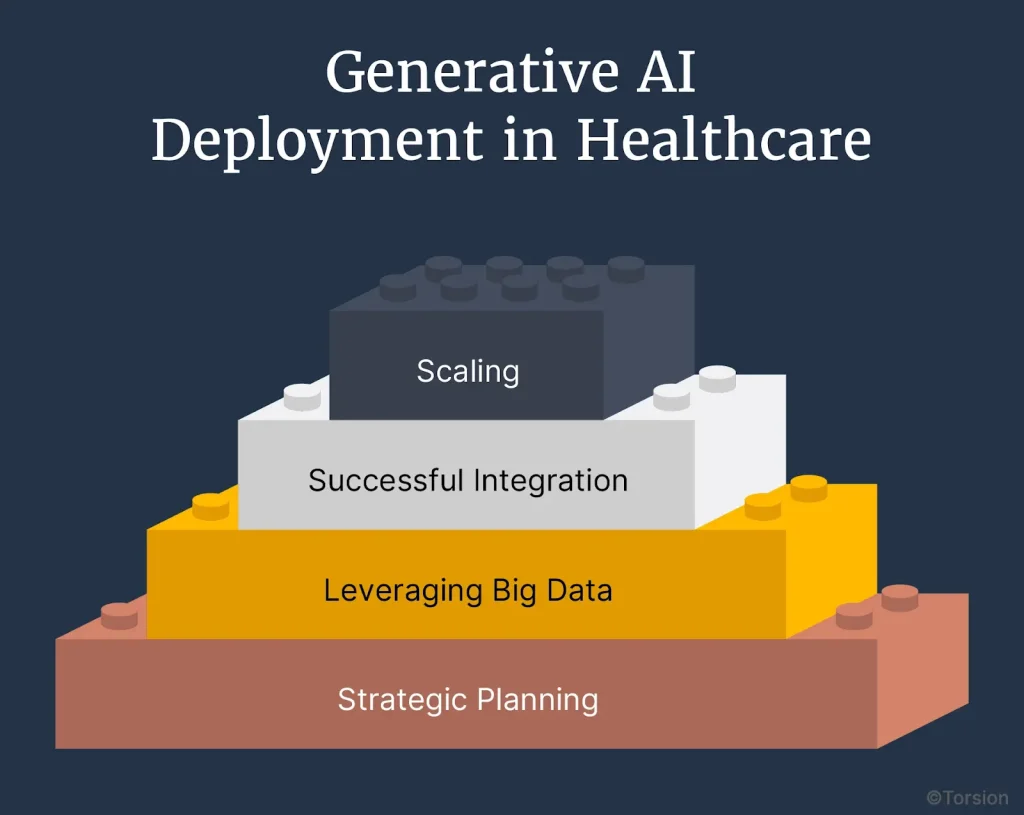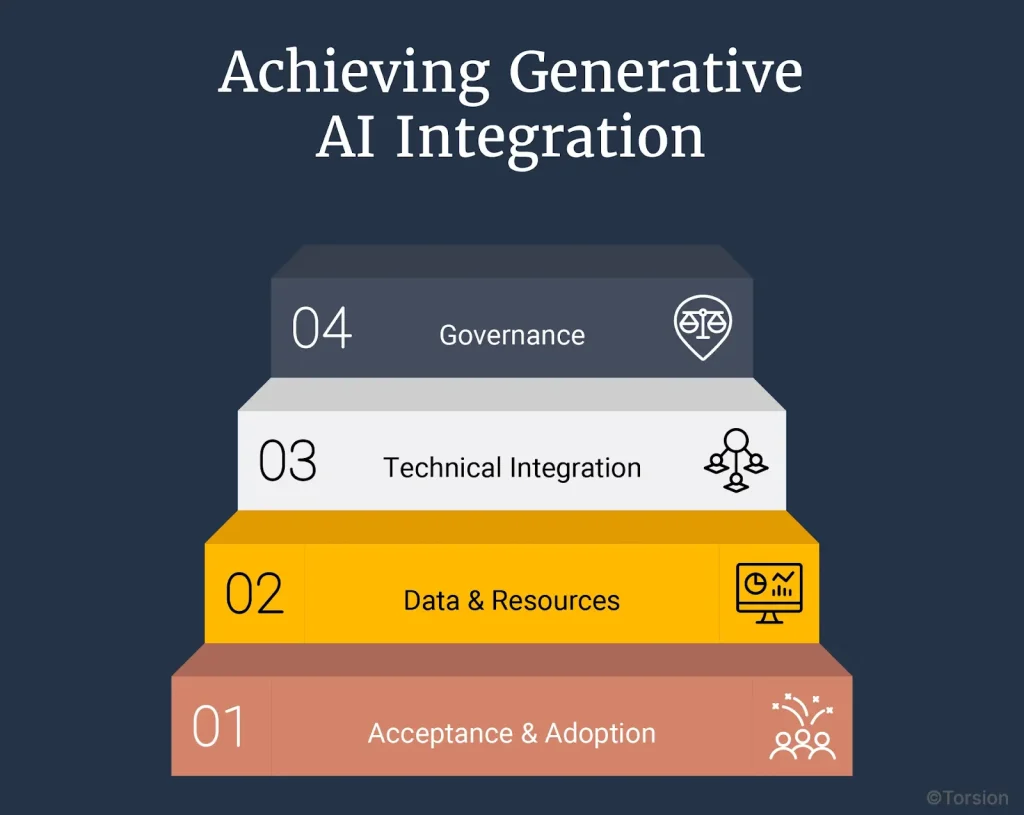Key Points
• GenAI shows clear returns on investment: Payers can cut admin costs by 13-25% lower medical expenses by 5-11%, and raise revenue by 3-12% if they use Enterprise AI.
• Start small to scale: Begin with simple and impactful areas like automating clinical paperwork or using chatbots to assist members. Once you succeed there, you can move to harder processes.
• Good data is the base: About 80% of healthcare data is scattered and unstructured. To make Enterprise AI work, organizations need to focus on improving data integration and governance first.
• Partner instead of building from scratch: Around 61% of effective payers team up with expert vendors instead of creating Enterprise AI tools in-house. This helps them see results faster and lowers the risk of failed implementations.
• Human oversight stays crucial: Keep clinical expertise in charge while blending in automation. Enterprise AI should play the role of a helpful tool, not act as an independent decision-maker in healthcare work.
The talk about Generative AI in healthcare has taken a new turn. It has moved from being just an idea to becoming an urgent priority. Over 70% of healthcare organizations have started exploring or using GenAI tools [23]. The stats show a clear picture: the generative AI market within healthcare is expected to hit $2.7 billion this year and could grow to almost $17 billion by 2034 [24].
Healthcare payers face enormous pressure today. In the first half of 2024, health plans saw their total net income drop by 14% compared to the same period last year. This challenging situation also opens doors for change. Adopting Enterprise AI has the potential to cut administrative costs by 13 to 25%. The numbers paint a clearer picture: with every $10 billion in payer revenue, Enterprise AI could reduce administrative spending by $150 to $300 million and medical costs by $380 to $970 million. It could also increase revenues by $260 million to $1.24 billion.
Things are already changing. Healthcare payers no longer ask “if” they should use GenAI; now they ask how they can make it happen. Even though they trail behind in digital progress, their willingness to take risks in Enterprise AI projects appears to be increasing, which could speed up adoption. The struggle is obvious: many payers are stuck in what experts describe as “pilot purgatory,” testing ideas without achieving meaningful results.
To move ahead, they need to zero in on impactful use cases that show real and measurable benefits. Around 60% Enterprise AI users already report clear returns or expect them soon. Those who take bold steps today will lead this change, while those who hesitate might get left behind.
2025: The Year GenAI Transforms from Testing to Reality

The healthcare insurance industry faces a pivotal point. Economic challenges have grown beyond what was once manageable. The use of medical services now surpasses forecasts, providers demand higher rates during negotiations, and Medicare Advantage finds itself under financial strain [1]. This combination of factors elevates GenAI from a simple tech project to a crucial tool for sustaining strategies.
Payers Choose Collaboration Instead of DIY Approaches
The way organizations adopt GenAI shows an interesting trend. 20% of payers build these tools. Most, about 61%, choose to team up with expert vendors to create tailored solutions [27]. This change in strategy highlights a focus on speed to launch rather than keeping everything in-house.
Working with partners provides companies with a practical way to take an idea and turn it into reality. Models like the services offered by Torsion’s Discovery & Strategy help businesses move faster while tapping into specialists’ knowledge. It’s a smart move because enterprise-level Enterprise AIsystems are not simple projects to handle alone.
Data Pushes the Need for Speed
Modern Enterprise AI tools provide payers with a unique chance to achieve three key benefits. They can lower administrative costs between 13 and 25 percent. They help reduce medical expenses by 5 to 11 percent. They might even boost revenue by 3 to 12 percent. This explains why by the end of 2024, 85% of healthcare leaders were either looking into or using GenAI features.
The market’s progress highlights the need for action. At $1.8 billion in 2023, the GenAI healthcare sector is set to expand with an annual growth rate of 33.2% through 2032. Gartner predicts that by 2027, GenAI tools will cut administrative expenses by 30% for health insurers with over one million members.
Active Adoption Surpasses Testing
The difference now lies in the market’s readiness. Many groups have left behind the stage of just testing ideas. More organizations are using these solutions today than just experimenting with them. This shift shows that GenAI has moved beyond being a theoretical possibility and now brings real measurable benefits.
Organizations adopting GenAI are showing it works for business. Of those already using it, 64% see a return on investment. In healthcare, 70% of payers are now applying these tools beyond just testing phases.
To get out of endless pilot testing, payers can use the GenAI Weather Map. This tool helps assess readiness and find the best way to start. The question isn’t whether to adopt—it’s how fast you can go beyond pilots to real-world results.
Eight Big GenAI Use Cases Healthcare Payers Should Know About

These eight ready-to-use applications reveal how generative AI is bringing clear benefits to healthcare payers by 2025:
1. Streamlining clinical documentation
Doctors lose 34-55% of their day filling out clinical documentation draining $90-140 billion each year from the US healthcare system [6]. GenAI eases this challenge by using automation to handle note-taking during patient visits. Tools like ambientEnterprise AIscribes give doctors back almost an hour every day [7]. Imagine having a helper that never gets tired, capturing every important point so medical professionals can prioritize their patients.
2. Improving member assistance through chatbots
Healthcare chatbots could grow into a $10.26 billion market by 2034. These virtual helpers work non-stop to assist with booking appointments, reminding users about medicines, and responding to member inquiries. Today, 21% of healthcare organizations use chatbots to handle patient questions, and this percentage keeps rising .
3. Using analytics to predict high-risk patients
Predictive tools help spot patients who might face expensive health issues before problems escalate. Nearly 75% of healthcare executives believe these analytic tools will improve patient outcomes. Advanced tools now achieve C-statistics over 0.70 when predicting high-risk patients with conditions like CKD and T2D.
4. Simplifying how prior authorization works
Physician practices lose $528 million every year due to prior authorization delays. One big insurance company usedEnterprise AImaking the process 1,400 times faster. Because of this, doctors gained back 12 hours a week that they used to spend on these requests.
5. Spotting fraud
Fraud in healthcare eats up 3-10% of total spending. Generative AI looks at thousands of claims each day and catches unusual billing while it happens. In one case, this system saved $10 million during its first year of use.
6. Boosting the accuracy of provider data
Bad data leads to coverage denials, wrong treatment paths, and higher costs. GenAI manages data quality by automating the process, keeping provider directories and patient details correct without needing manual checks.
7. Boosting value-based care models
GenAI spots health trends in populations and customizes care plans. This helps payers send resources to patients at higher risk. It combines information from different systems to use value-based care efforts.
8. Cutting administrative burden
Administrative tasks cost $335 billion every year. Enterprise AI could remove over half of this spending. GenAI automates repetitive work, which 57% of doctors say is their top reason for wanting Enterprise AI in healthcare.
Download our eBook to learn about more impactful use cases and evaluate if your organization is ready using our GenAI Weather Map framework.
Why GenAI Stalls: Challenges to Progress
Even with strong business reasons to adopt GenAI many payers hit walls that decide if they can scale it or get stuck in endless pilot phases. These challenges are real and call for smart solutions.
Data silos form the core issue
Old systems stand as the biggest roadblocks to GenAI efforts. Many payers work within disconnected systems—Facets is in one place, InterQual in another, and SharePoint everywhere—that cannot work together [21]. Without connected data access even advanced Enterprise AI tools fail to bring real value.
The numbers paint a clear picture. Around 80% of healthcare data remains unstructured and spread across separate systems leaving teams stuck with manual methods that make quick decisions almost impossible. Fragmented data prevents teams from gaining a full 360° view needed to create personalized experiences. Fixing this core issue is essential to allow Enterprise AI to thrive.
Regulatory confusion makes deployment harder
The rules around healthcare Enterprise AI are still not formed. Although the Biden-Harris Administration has set some basic guidelines federal agencies can exercise limited control over Enterprise AI tools [25]. This raises serious risks like unauthorized access to private health data [26].
The “black box” issue makes things even more difficult. Algorithms that cannot be explained lead to mistrust and the chance of running into FCA liability problems [2]. To expand Enterprise AI in critical areas of healthcare, organizations must create systems to ensure accountability and openness.
Cultural hurdles delay progress
Resistance arises from how organizations operate rather than because of technology limits. People often doubt the advantages of Enterprise worry about losing jobs, or feel uneasy about changing traditional processes. Many reports from the industry also point out that training the healthcare workforce poses a big challenge.
Use our self-assessment framework to see how ready your organization is to adopt GenAI.
Payers often struggle with handling major innovation. Shifting from isolated systems to collaborative models isn’t easy. Services like Discovery & Strategy offer solutions to address these issues through focused ways to manage change.
Balancing human roles with AI
Finding the right mix of automation and human oversight is still a challenge. If there is too little oversight patient care can face significant risks. On the other hand, adding too much “human in the loop” design puts more pressure on caregivers who are already overwhelmed. Enterprise AI should act as a helpful assistant, not as the sole decision-maker for healthcare.
Achieving success depends on using optimization and governance frameworks. These frameworks need to create clear rules to oversee AI-assisted decisions and ensure models remain accurate over time. Health organizations that master this balance can stand out from others stuck in endless pilot tests.
Creating a GenAI Strategy Ready for Real-World Impact

[Trademarked: Damo Consulting]
Building lasting GenAI success means concentrating on well-thought-out strategies instead of testing random ideas. By looking at how healthcare leaders use it , payers can plan to shift from stalled pilot programs to real-world results.
Start with proven high-value opportunities
Smart payers pick areas that show a strong return—like handling enrollment better, fixing billing systems, or improving how members get information. Top healthcare groups focus their efforts where they have solid data, clear processes, and results they can measure. Their formula is straightforward: show value and expand step by step.
Use our self-assessment framework to find the best first steps for your organization.
This focuses less on being careful and more on being smart with your approach. Teams that show quick wins can earn trust and secure resources to expand their efforts.
Create strong data systems at an enterprise level
Good data drives GenAI success. Around 80% of healthcare data still exists in disconnected and unstructured forms [32]. To use Enterprise AI on a large scale, payers need to build connected data systems. Teams that succeed make strict rules to ensure their data is complete, accurate, and free of bias [5].
The truth is simple: bad data makes even the best Enterprise AI solutions fail. Groups require clear data practices to track its sources, confirm its quality, and follow the rules [32]. Our Discovery & Strategy services guide payers step by step in building these important data systems.
Set up scalable enterprise AIsystems that follow regulations
Payers require adaptable platforms that fit with current systems and allow room to improve over time. Instead of doing a full replacement of main systems right away top companies collaborate with vendors who provide proven Enterprise AI solutions tailored to healthcare.
The focus should be on picking tools that can grow from small projects to full-scale use without needing a complete system change.
Create teams ready to use Enterprise AI and unite leadership
Building talent requires more than just teaching technical skills. It demands changing workplace culture. In healthcare digital maturity hasn’t kept pace with other industries so broad upskilling becomes a key requirement. Clinicians need set-aside time to engage, along with rewards that motivate them to embrace Enterprise AI in their work.
Getting leaders on the same page matters just as much. Enterprise AI projects thrive when they tie into an organization’s core strategies and have backing from executives through rollout and beyond. At Torsion, we maintain this focus with our Optimization and Governance framework ensuring Enterprise AIsystems stay aligned as they grow and shift.
Reach out to Torsion to create your tailored GenAI strategy
Shifting from Ideas to Production-Ready GenAI
The healthcare payer industry faces a major turning point. GenAI is no longer just a test run; it is now crucial to staying competitive. The financial benefits are undeniable. It helps cut administrative costs, lower medical expenses, and create new revenue streams that most organizations can’t afford to overlook.
The divide between top performers and those falling behind is growing fast. Some payers are stuck testing without moving forward. Meanwhile, others are putting large-scale effective solutions into action and seeing real results. The real issue is in how organizations choose to execute their plans.
At Torsion, we understand what sets apart successful GenAI projects from the ones that don’t work out. Teams that succeed focus on use cases with big potential and manageable risk, set up strong data systems, and design flexible structures right from the beginning. They know that GenAI success needs more than just tools. It requires aligning with company culture, having clear rules in place, and creating detailed plans to tie Enterprise AI efforts to real business goals.
Challenges like scattered data, strict regulations, resistant mindsets, and limited skilled workers are real, but they are not dealbreakers. These obstacles can turn into strengths for companies that tackle them step by step.
Curious about taking Enterprise AI past the experimentation phase? Download our GenAI Weather Map to evaluate how mature your organization’s Enterprise AI approach is and uncover your biggest opportunities. Reach out to Torsion to build a step-by-step plan that turns GenAI’s potential into real meaningful results.
The path forward is obvious. The move from small experiments to integrated Enterprise AI systems is already happening. The real question isn’t if GenAI will transform healthcare payers but whether your team will drive that change or spend 2025 trying to catch up.
References
[1] – https://healthtechmagazine.net/article/2025/01/overview-2025-ai-trends-healthcare
[2] – https://www.weforum.org/stories/2025/03/ai-transforming-global-health/
[3] – https://www.omegahms.com/blog/2025-payer-trends/
[4] – https://www.mckinsey.com/industries/healthcare/our-insights/rewiring-healthcare-payers-a-guide-to-digital-and-ai-transformation
[5] – https://blog.hilabs.com/blog/the-2025-landscape-key-ai-trends-shaping-healthcare-payers-ecosystem-today
[6] – https://www.mckinsey.com/industries/healthcare/our-insights/the-ai-opportunity-how-payers-can-capture-it-now
[7] – https://www.mckinsey.com/industries/healthcare/our-insights/generative-ai-in-healthcare-current-trends-and-future-outlook
[8] – https://www.gminsights.com/industry-analysis/generative-ai-in-healthcare-market
[9] – https://www.inovaare.com/ai-reshapes-how-us-healthcare-payer-cios-do-business-generative-ai-for-payers/
[10] – https://www.healthcareitnews.com/news/healthcare-ai-adoption-data-and-integration-challenges-persist
[11] – https://ahisp.ahima.org/Page/improving-clinical-documentation-with-artificial-intelligence-a-systematic-review
[12] – https://www.cnbc.com/2024/03/16/himss-2024-ambient-clinical-documentation-steals-the-show.html
[13] – https://www.coherentsolutions.com/insights/how-ai-chatbots-advance-healthcare-for-patients-and-providers
[14] – https://randstaddigital.com/insights/blogs/managed-solutions/transforming-patient-healthcare-with-predictive-analysis/
[15] – https://pmc.ncbi.nlm.nih.gov/articles/PMC8796116/
[16] – https://aws.amazon.com/blogs/apn/streamlining-prior-authorization-with-treatline-generative-ai-platform-for-healthcare-and-insurance-providers/
[17] – https://www.oliverwyman.com/our-expertise/perspectives/health/2024/september/unlocking-the-potential-of-ai-in-prior-authorization.html
[18] – https://www.advisory.com/daily-briefing/2024/07/16/ai-prior-authorization
[19] – https://www.sciencedirect.com/science/article/pii/S0933365724003038
[20] – https://www.clariontech.com/blog/leveraging-ai-for-healthcare-fraud-detection-a-game-changer-for-ctos
[21] – https://cxotechmagazine.com/using-generative-ai-to-improve-data-quality/
[22] – https://www.primary.vc/firstedition/posts/is-generative-ai-a-catalyst-for-value-based-care/
[23] – https://guidehouse.com/insights/healthcare/2024/ai-and-data-value-based-payment-models
[24] – https://www.sciencedirect.com/science/article/abs/pii/S0749806325002166
[25] – https://www.ama-assn.org/practice-management/digital-health/physicians-greatest-use-ai-cutting-administrative-burdens
[26] – https://www.glean.com/blog/ai-for-healthcare-payers
[27] – https://hart.com/blog/breaking-down-data-silos-in-healthcare
[28] – https://healthtechmagazine.net/article/2025/04/how-do-data-silos-impede-patient-care-and-provider-efficiency
[29] – https://www.dataideology.com/how-healthcare-payers-can-breakdown-their-data-silos/
[30] – https://www.ahima.org/education-events/artificial-intelligence/artificial-intelligence-regulatory-resource-guide/
[31] – https://pmc.ncbi.nlm.nih.gov/articles/PMC10930608/
[32] – https://www.morganlewis.com/pubs/2025/07/ai-in-healthcare-opportunities-enforcement-risks-and-false-claims-and-the-need-for-ai-specific-compliance
[33] – https://healthedge.com/resources/blog/wf-creating-a-culture-of-innovation-to-accelerate-ai-adoption
[34] – https://pmc.ncbi.nlm.nih.gov/articles/PMC10623210/
[35] – https://cloud.google.com/transform/unlocking-ais-potential-in-healthcare-balancing-innovation-and-responsibility-gen-ai
[36] – https://www.um.edu.mt/library/oar/bitstream/123456789/125742/1/Artificial intelligence in healthcare balancing automation and human oversight 2024.pdf
[37] – https://www.bain.com/insights/getting-the-most-out-of-generative-ai-in-healthcare/
[38] – https://healthtechmagazine.net/article/2025/02/ai-data-governance-in-healthcare-perfcon
[39] – https://pmc.ncbi.nlm.nih.gov/articles/PMC12075486/
[40] – https://pmc.ncbi.nlm.nih.gov/articles/PMC11358667/
[41] – https://www.ama-assn.org/practice-management/digital-health/they-push-ahead-ai-health-leaders-must-set-rules-use





